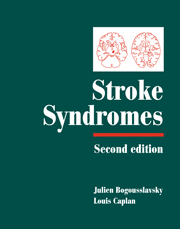Book contents
- Frontmatter
- Contents
- List of contributors
- Preface
- PART I CLINICAL MANIFESTATIONS
- PART II VASCULAR TOPOGRAPHIC SYNDROMES
- 29 Arterial territories of human brain
- 30 Superficial middle cerebral artery syndromes
- 31 Lenticulostriate arteries
- 32 Anterior cerebral artery
- 33 Anterior choroidal artery territory infarcts
- 34 Thalamic infarcts and hemorrhages
- 35 Caudate infarcts and hemorrhages
- 36 Posterior cerebral artery
- 37 Large and panhemispheric infarcts
- 38 Multiple, multilevel and bihemispheric infarcts
- 39 Midbrain infarcts
- 40 Pontine infarcts and hemorrhages
- 41 Medullary infarcts and hemorrhages
- 42 Cerebellar stroke syndromes
- 43 Extended infarcts in the posterior circulation (brainstem/cerebellum)
- 44 Border zone infarcts
- 45 Classical lacunar syndromes
- 46 Putaminal hemorrhages
- 47 Lobar hemorrhages
- 48 Intraventricular hemorrhages
- 49 Subarachnoid hemorrhage syndromes
- 50 Brain venous thrombosis syndromes
- 51 Carotid occlusion syndromes
- 52 Cervical artery dissection syndromes
- 53 Syndromes related to large artery thromboembolism within the vertebrobasilar system
- 54 Spinal stroke syndromes
- Index
- Plate section
45 - Classical lacunar syndromes
from PART II - VASCULAR TOPOGRAPHIC SYNDROMES
Published online by Cambridge University Press: 17 May 2010
- Frontmatter
- Contents
- List of contributors
- Preface
- PART I CLINICAL MANIFESTATIONS
- PART II VASCULAR TOPOGRAPHIC SYNDROMES
- 29 Arterial territories of human brain
- 30 Superficial middle cerebral artery syndromes
- 31 Lenticulostriate arteries
- 32 Anterior cerebral artery
- 33 Anterior choroidal artery territory infarcts
- 34 Thalamic infarcts and hemorrhages
- 35 Caudate infarcts and hemorrhages
- 36 Posterior cerebral artery
- 37 Large and panhemispheric infarcts
- 38 Multiple, multilevel and bihemispheric infarcts
- 39 Midbrain infarcts
- 40 Pontine infarcts and hemorrhages
- 41 Medullary infarcts and hemorrhages
- 42 Cerebellar stroke syndromes
- 43 Extended infarcts in the posterior circulation (brainstem/cerebellum)
- 44 Border zone infarcts
- 45 Classical lacunar syndromes
- 46 Putaminal hemorrhages
- 47 Lobar hemorrhages
- 48 Intraventricular hemorrhages
- 49 Subarachnoid hemorrhage syndromes
- 50 Brain venous thrombosis syndromes
- 51 Carotid occlusion syndromes
- 52 Cervical artery dissection syndromes
- 53 Syndromes related to large artery thromboembolism within the vertebrobasilar system
- 54 Spinal stroke syndromes
- Index
- Plate section
Summary
Introduction
Few aspects of cerebrovascular disease have generated such intense debate as that of lacunar stroke, although in recent years there has been a more reflective appraisal of the validity and utility of the central tenets of the concept. At the outset, in order to avoid the confusion which is rife in the literature, one needs to have a clear understanding of the terminology.
The term lacune is best reserved for a pathological lesion observed at autopsy. A complete classification of lacunes will include the residua of small hemorrhages and also dilatation of the perivascular spaces, but the term is usually used to describe an area of infarction within the territory of a single perforating artery (Poirier & Derouesne, 1984).
In theory, CT and MRI allow us to image lacunes in vivo, but there have been very few cases in the literature that have demonstrated precise radiological–pathological correlation, and use of the term lacune as a purely radiological phenomenon should be discouraged. I will use the more neutral term small, deep infarct (SDI), with the presumption that the imaged area of infarction is within the territory of a single perforating artery, although on this matter there is clearly considerable inter- and intraindividual variation (Van der Zwan, 1991). A convention has evolved that, for an SDI to equate with a lacune, the maximum diameter of the imaged lesion should be no greater than 1.5 cm, a figure derived from the original pathological studies which, for the most part, were of chronic lesions (Fisher 1965a, 1969).
- Type
- Chapter
- Information
- Stroke Syndromes , pp. 583 - 589Publisher: Cambridge University PressPrint publication year: 2001
- 5
- Cited by



